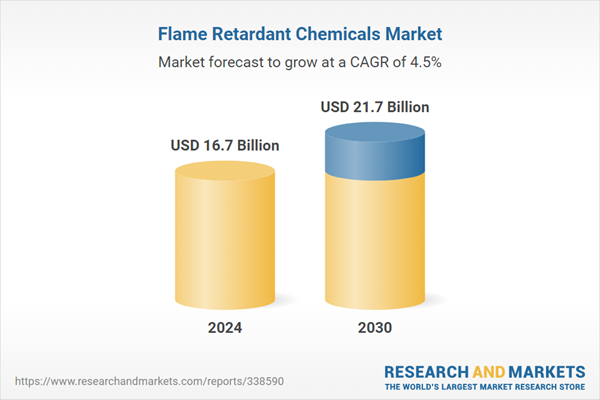The global market for Flame Retardant Chemicals was valued at US$16.7 Billion in 2024 and is projected to reach US$21.7 Billion by 2030, growing at a CAGR of 4.5% from 2024 to 2030. This comprehensive report provides an in-depth analysis of market trends, drivers, and forecasts, helping you make informed business decisions. The report includes the most recent global tariff developments and how they impact the Flame Retardant Chemicals market.
Segments: Product Type (Phosphorous, Brominated, Inorganic, Other Product Types); End-Use (Buildings & Construction, Electrical & Electronics, Transportation, Other End-Uses).
Geographic Regions/Countries: World; United States; Canada; Japan; China; Europe (France; Germany; Italy; United Kingdom; Spain; Russia; and Rest of Europe); Asia-Pacific (Australia; India; South Korea; and Rest of Asia-Pacific); Latin America (Argentina; Brazil; Mexico; and Rest of Latin America); Middle East (Iran; Israel; Saudi Arabia; United Arab Emirates; and Rest of Middle East); and Africa.
The analysts continuously track trade developments worldwide, drawing insights from leading global economists and over 200 industry and policy institutions, including think tanks, trade organizations, and national economic advisory bodies. This intelligence is integrated into forecasting models to provide timely, data-driven analysis of emerging risks and opportunities.
Global Flame Retardant Chemicals Market - Key Trends & Drivers Summarized
What Are Flame Retardant Chemicals and Why Are They Important?
Flame retardant chemicals are substances added to materials to prevent or slow the spread of fire. These chemicals are essential in enhancing the fire safety of various products, including textiles, plastics, electronics, and construction materials. Flame retardants work by inhibiting or delaying the combustion process, reducing the risk of fire-related injuries and property damage. There are several types of flame retardants, including brominated, phosphorus-based, nitrogen-based, and inorganic compounds, each suited for specific applications. The critical role of flame retardant chemicals in improving fire safety standards underscores their importance in protecting lives and property in numerous settings.How Are Flame Retardant Chemicals Utilized in Different Industries?
Flame retardant chemicals are utilized across multiple industries, reflecting their significance in enhancing fire safety. In the construction industry, flame retardants are added to building materials such as insulation, coatings, and electrical cables, reducing the risk of fire spread and ensuring compliance with fire safety regulations. The electronics industry uses flame retardants in components such as circuit boards, connectors, and housings to prevent electrical fires and protect sensitive equipment. In the automotive sector, flame retardants are incorporated into interior materials, wiring, and engine components to enhance vehicle safety. The textile industry employs flame retardants in fabrics used for upholstery, clothing, and industrial applications, providing additional protection against fire hazards. These diverse applications highlight the essential role of flame retardant chemicals in safeguarding various products and environments from fire risks.What Are the Environmental and Health Considerations?
The production and use of flame retardant chemicals involve environmental and health considerations that must be addressed to ensure safety and sustainability. Some flame retardants, particularly brominated compounds, have been associated with environmental persistence and bioaccumulation, posing risks to wildlife and human health. Exposure to certain flame retardants can lead to health issues such as endocrine disruption, reproductive toxicity, and cancer. To mitigate these risks, industries are shifting towards the development and use of safer, more environmentally friendly flame retardants, such as phosphorus-based and inorganic compounds. Regulatory frameworks and international standards govern the production, usage, and disposal of flame retardant chemicals, promoting safer alternatives and responsible practices to protect the environment and public health.What Is Driving the Growth in the Flame Retardant Chemicals Market?
The growth in the flame retardant chemicals market is driven by several factors, including increasing demand for fire-safe materials, stringent fire safety regulations, and technological advancements. The rising awareness of fire safety and the need to protect lives and property drive the demand for flame retardant chemicals in various industries. Stringent fire safety regulations and building codes mandate the use of flame retardants in construction materials, electronics, and consumer products, boosting market growth. Technological advancements in flame retardant formulations have led to the development of more effective and environmentally friendly products, enhancing market competitiveness. Additionally, the growing emphasis on sustainability and the development of bio-based flame retardants shape the market landscape, encouraging the adoption of safer and more sustainable practices. These drivers highlight the dynamic and evolving nature of the flame retardant chemicals market, balancing industrial demands with environmental and health considerations.Report Scope
The report analyzes the Flame Retardant Chemicals market, presented in terms of units. The analysis covers the key segments and geographic regions outlined below.Segments: Product Type (Phosphorous, Brominated, Inorganic, Other Product Types); End-Use (Buildings & Construction, Electrical & Electronics, Transportation, Other End-Uses).
Geographic Regions/Countries: World; United States; Canada; Japan; China; Europe (France; Germany; Italy; United Kingdom; Spain; Russia; and Rest of Europe); Asia-Pacific (Australia; India; South Korea; and Rest of Asia-Pacific); Latin America (Argentina; Brazil; Mexico; and Rest of Latin America); Middle East (Iran; Israel; Saudi Arabia; United Arab Emirates; and Rest of Middle East); and Africa.
Key Insights:
- Market Growth: Understand the significant growth trajectory of the Phosphorous segment, which is expected to reach US$8.1 Billion by 2030 with a CAGR of a 5.2%. The Brominated segment is also set to grow at 4.5% CAGR over the analysis period.
- Regional Analysis: Gain insights into the U.S. market, valued at $4.5 Billion in 2024, and China, forecasted to grow at an impressive 7.6% CAGR to reach $4.6 Billion by 2030. Discover growth trends in other key regions, including Japan, Canada, Germany, and the Asia-Pacific.
Why You Should Buy This Report:
- Detailed Market Analysis: Access a thorough analysis of the Global Flame Retardant Chemicals Market, covering all major geographic regions and market segments.
- Competitive Insights: Get an overview of the competitive landscape, including the market presence of major players across different geographies.
- Future Trends and Drivers: Understand the key trends and drivers shaping the future of the Global Flame Retardant Chemicals Market.
- Actionable Insights: Benefit from actionable insights that can help you identify new revenue opportunities and make strategic business decisions.
Key Questions Answered:
- How is the Global Flame Retardant Chemicals Market expected to evolve by 2030?
- What are the main drivers and restraints affecting the market?
- Which market segments will grow the most over the forecast period?
- How will market shares for different regions and segments change by 2030?
- Who are the leading players in the market, and what are their prospects?
Report Features:
- Comprehensive Market Data: Independent analysis of annual sales and market forecasts in US$ Million from 2024 to 2030.
- In-Depth Regional Analysis: Detailed insights into key markets, including the U.S., China, Japan, Canada, Europe, Asia-Pacific, Latin America, Middle East, and Africa.
- Company Profiles: Coverage of players such as Albemarle Corporation, BASF SE, Clariant International Ltd., Dow Inc., Lanxess AG and more.
- Complimentary Updates: Receive free report updates for one year to keep you informed of the latest market developments.
Some of the 23 companies featured in this Flame Retardant Chemicals market report include:
- Albemarle Corporation
- BASF SE
- Clariant International Ltd.
- Dow Inc.
- Lanxess AG
- Nouryon
Tariff Impact Analysis: Key Insights for 2025
Global tariff negotiations across 180+ countries are reshaping supply chains, costs, and competitiveness. This report reflects the latest developments as of April 2025 and incorporates forward-looking insights into the market outlook.The analysts continuously track trade developments worldwide, drawing insights from leading global economists and over 200 industry and policy institutions, including think tanks, trade organizations, and national economic advisory bodies. This intelligence is integrated into forecasting models to provide timely, data-driven analysis of emerging risks and opportunities.
What’s Included in This Edition:
- Tariff-adjusted market forecasts by region and segment
- Analysis of cost and supply chain implications by sourcing and trade exposure
- Strategic insights into geographic shifts
Buyers receive a free July 2025 update with:
- Finalized tariff impacts and new trade agreement effects
- Updated projections reflecting global sourcing and cost shifts
- Expanded country-specific coverage across the industry
Table of Contents
I. METHODOLOGYII. EXECUTIVE SUMMARY2. FOCUS ON SELECT PLAYERSIII. MARKET ANALYSISSOUTH KOREAREST OF ASIA-PACIFICARGENTINABRAZILMEXICOREST OF LATIN AMERICAIRANISRAELSAUDI ARABIAUNITED ARAB EMIRATESREST OF MIDDLE EASTIV. COMPETITION
1. MARKET OVERVIEW
3. MARKET TRENDS & DRIVERS
4. GLOBAL MARKET PERSPECTIVE
UNITED STATES
CANADA
JAPAN
CHINA
EUROPE
FRANCE
GERMANY
ITALY
UNITED KINGDOM
SPAIN
RUSSIA
REST OF EUROPE
ASIA-PACIFIC
AUSTRALIA
INDIA
LATIN AMERICA
MIDDLE EAST
AFRICA
Table Information
| Report Attribute | Details |
|---|---|
| No. of Pages | 186 |
| Published | April 2025 |
| Forecast Period | 2024 - 2030 |
| Estimated Market Value ( USD | $ 16.7 Billion |
| Forecasted Market Value ( USD | $ 21.7 Billion |
| Compound Annual Growth Rate | 4.5% |
| Regions Covered | Global |









